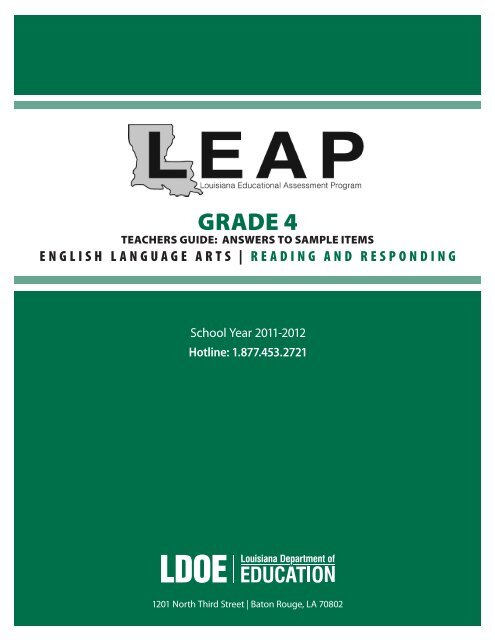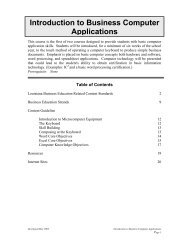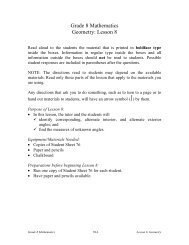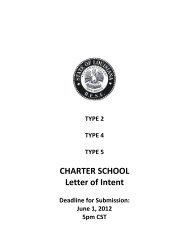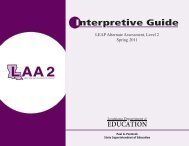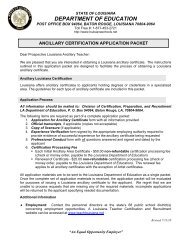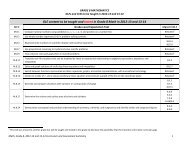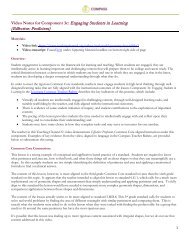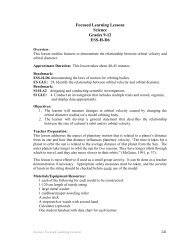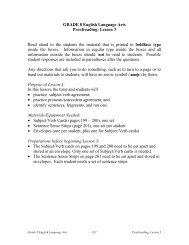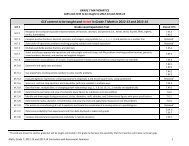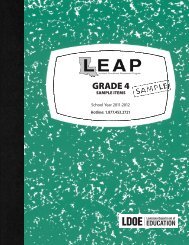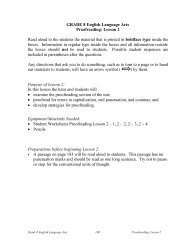Reading & Responding - Louisiana Department of Education
Reading & Responding - Louisiana Department of Education
Reading & Responding - Louisiana Department of Education
Create successful ePaper yourself
Turn your PDF publications into a flip-book with our unique Google optimized e-Paper software.
LESSON 1 - “ONE DAY”2Content Standard:7.3: Recognize an author’s purpose and point <strong>of</strong> viewIntroduction toStudents:To know how the author thinks about the subject, it is helpful to understand the mainidea <strong>of</strong> the poem. It is also helpful to understand how the author feels about the subjector what the poem is mostly about. You can do this by asking yourself questions as youread:••What is the poem mostly about?••How does the poet feel about what is happening in the poem?••What in the poem tells me this?In this poem, the author writes about the characters and what happens in a playfulway (the father “winked and smiled”; the family goes for ice cream in the morning; thesunset is aglow with color). The author describes what happens when the town clockbreaks and then thinks about the idea <strong>of</strong> time stopping.If you answered A, C, or D, your answer is incorrect. Let’s talk about why. Think about what happens in the poemand how the writer feels about what happens.Which is most likely true about the writer?A. The writer wishes to be Peter Pan. (What is the problem with this answer? Although a boy in the poemmakes a wish to be Peter Pan, the writer does not wish to stay a child forever.)B. The writer likes to imagine time stopping. Correct. You can tell from how the poet describes whathappens in the poem that the poet enjoys thinking about what would happen if time stopped.C. The writer thinks all clocks should be broken. (What is the problem with this answer? Although a clockdoes break in the poem, the writer doesn’t want all clocks to be broken. At the end <strong>of</strong> the poem, the writereven says that “Days end / whether you measure them or not.”)D. The writer likes to watch the sun set. (What is the problem with this answer? Although the poem endswith a sunset, you can’t tell from the poem whether or not the writer likes to watch the sun set.)LEAPGrade 4 | Teachers GuideELA | READING AND RESPONDING4
LESSON 3 - “ONE DAY”1Content Standard:7.2: Problem solve by using reasoning skills, life experiences, and available informationIntroduction toStudents:This question asks you to figure out something that is not directly stated in the poem.In order to answer the question, you have to look for clues in the poem. You might alsothink about real life and how you might know what time it is without a clock. If you areplaying outside in the late afternoon and you don’t have a watch, how do you knowwhen it is time to go home?When you think about what happens in the poem and you think about what you knowfrom real life, you can find the best answer to this question.If you answered B, C, or D, your answer is incorrect. Let’s talk about why. Think about how the speaker knows thatthe day is coming to an end.Based on this poem, how might you tell time if your clock breaks?A. by watching the sun Correct. The speaker knows the day is ending because the sun is setting. You can tellwhat time it is by where the sun is. This is the best answer.B. by asking your mom (What is the problem with this answer? The mother in the poem is wise, but she doesnot tell the speaker what time it is.)C. by spending time with dad (What is the problem with this answer? The speaker has fun with the father,but the father does not tell the speaker what time it is.)D. by wishing to be Peter Pan (What is the problem with this answer? A boy in the poem does wish to bePeter Pan, but this does not help anyone know what time it is.)When the sun sets at the end <strong>of</strong> the poem, the speaker knows that the day has ended. Watching the sun helpsthe speaker know the time.LEAPGrade 4 | Teachers GuideELA | READING AND RESPONDING7
LESSON 3 - “ONE DAY”2Content Standard:7.1: Use comprehension strategies (e.g., sequencing, predicting, drawing conclusions,comparing and contrasting, making inferences, determining main ideas) in contextsIntroduction toStudents:This question asks you to look carefully at a part <strong>of</strong> the poem. Then you are asked t<strong>of</strong>igure out what the speaker means when the speaker says the mother was right. Thismeans you need to look back at the part <strong>of</strong> the poem that tells what the mother says.Compare what the mother says to what happens in the poem. When you do this, youcan answer the question.To answer the question, you need to know:• what does the mother say?• how does the speaker know the mother is right?In the poem, the mother says that “days end whether you measure them or not.” What shows the speaker thatthe mother’s words are right?At the end <strong>of</strong> the poem, what does the speaker mean by “Mom is right!”?Sample Answer: Mom says that “days end whether you measure them or not.” You can tell that she was rightbecause the day ends as the poem ends.This answer tells what the mother said (“days end whether you measure them or not”) and why she is right(“the day ends as the poem ends”).LEAPGrade 4 | Teachers GuideELA | READING AND RESPONDING8
Read the following passage, and then answer the questions that follow.A Penguin MysteryHow did a South American penguin end up in Alaska? Zoologists wonder how a Humboldt penguinmade the journey from the west coast <strong>of</strong> South America to Alaska in the summer <strong>of</strong> 2002. This is a journey<strong>of</strong> about 7,000 miles!Native to Chile and Peru, Humboldt penguins live on the coast <strong>of</strong> the Pacific Ocean, where watersare cold and there are many fish. The cold Alaskan waters are well-suited to penguins, too. Zoologistssay that penguins would easily find herring and other fish <strong>of</strong>f the coast <strong>of</strong> Alaska. The warm waters inbetween the South American shores and Alaska are another story. Zoologists doubt that the penguinswam the whole way, not just because it is a long distance. Zoologists think the penguin must havesomehow gotten a ride, mostly because the penguin probably would not have found enough food in thewarmer Pacific waters north <strong>of</strong> South America and south <strong>of</strong> Alaska. Besides, what would a cold-weatherbird like a penguin do in Hawaii?Because Humboldt penguins are sometimes kept as pets in Chile and Peru, zoologists think thepenguin might have been brought to Alaska aboard a fishing boat. Humboldt penguins are about the size<strong>of</strong> a cat, and weigh up to 15 pounds—small enough to hide as a stowaway on a ship. When the ship sailedhome, the penguin could have jumped ship in Alaskan water.Zoologists may never know how the penguin got to Alaska. But one thing is for sure: he had a longtrip home!LEAPGrade 4 | Teachers GuideELA | READING AND RESPONDING9
LESSON 4 - “A PENGUIN MYSTERY”1Content Standard:7.1: Use comprehension strategies (e.g., sequencing, predicting, drawing conclusions,comparing and contrasting, making inferences, determining main ideas) in contextsIntroduction toStudents:This question asks you to compare two places that are mentioned in the passage. Whenyou compare, you are looking for things that are the same.Ask yourself: What does the passage say about the west coast <strong>of</strong> South America that isthe same as the west coast <strong>of</strong> Alaska? You may find that you can answer this questioncorrectly without looking at the possible answers.If you answered A, B, or D, your answer is incorrect. Let’s talk about why. Think about what you know about SouthAmerica and Alaska after reading the passage.What do the waters around South America and Alaska have in common?A. many Humboldt penguins (What is the problem with this answer? The author says that Humboldtpenguins live in Chile and Peru, South America. It is a surprise to find a Humboldt penguin in Alaska,however.)B. warm Pacific water (What is the problem with this answer? Warm Pacific water is not found <strong>of</strong>f the westcoast <strong>of</strong> South America or Alaska.)C. fish penguins eat Correct. The author says that Humboldt penguins live on the coast <strong>of</strong> the Pacific Oceanin South America, where there are many fish. The passage also states that penguins could easily find fishto eat <strong>of</strong>f the coast <strong>of</strong> Alaska. This means a penguin could find fish to eat in both places. This is the bestanswer.D. pet penguins (What is the problem with this answer? The author says that Humboldt penguins weighabout as much as a 15-pound cat. While cats are common household pets, the author does not make thiscomparison. Even though the author does mention that “Humboldt penguins are sometimes kept as petsin Chile in Peru,” the author does not say that this is true in Alaska.)LEAPGrade 4 | Teachers GuideELA | READING AND RESPONDING10
LESSON 4 - “A PENGUIN MYSTERY”2Content Standard:7.4: Distinguish fact from opinion, skimming and scanning for facts, determining causeand effect, generating inquiry, and making connections with real-life situationsIntroduction toStudents:When you are looking for facts, you are looking for information that you can check tosee whether it is true. You could talk to zoologists who have studied the penguin, oryou could check the information with the news agencies that reported the story.Opinions and guesses are not facts. An opinion is one person’s belief or idea aboutsomething that cannot be proven or checked. For example, if someone says that theview from the top <strong>of</strong> a mountain is pretty, that is only an opinion. However, if someonemeasures the height <strong>of</strong> the mountain and tells you it is 10,000 feet tall, that is a fact thatyou can check. If someone guesses that the mountain might be 11,000 feet tall, that isnot really a fact; it is just a guess.For this question, a good way to find the best answer is to check the possible answersagainst the information in the passage.If you answered B, C, or D, your answer is incorrect. Let’s talk about why. Think about what you know about SouthAmerica and Alaska after reading the passage.Which is a fact about the Humboldt penguin in the passage?A. It was found in Alaska. Correct. A fact is true information. The penguin was found in Alaska in thesummer <strong>of</strong> 2002. We know this is a fact because it really happened. This is the best answer.B. It rode on a ship. (What is the problem with this answer? The passage says that the penguin may havebeen brought to Alaska on a boat. This is not a fact.)C. It was someone’s pet. (What is the problem with this answer? The passage says that the penguin mighthave been kept as a pet. This is not a fact.)D. It was a fast swimmer. (What is the problem with this answer? The passage says that scientists doubt thepenguin swam to Alaska, so we do not know whether the penguin was a fast swimmer.)LEAPGrade 4 | Teachers GuideELA | READING AND RESPONDING11
LESSON 5 - “A PENGUIN MYSTERY”1Content Standard:7.1: Use comprehension strategies (e.g., sequencing, predicting, drawing conclusions,comparing and contrasting, making inferences, determining main ideas) in contextsIntroduction toStudents:This question asks you to find the main reason for something that happened. When youare looking for a main reason, you must read carefully. Just because a fact is true doesnot mean it is the main reason. The main reason is the reason that would probably stillbe true even if other reasons were not true.It is helpful to reread parts <strong>of</strong> the passage in order to find the main reason forsomething.If you answered A, B, or C, your answer is incorrect. Let’s talk about why. Think about what the author says abouthow the penguin traveled. Reread the second paragraph.Zoologists think the penguin did not swim the whole way mostly becauseA. the distance would have been too far to swim. (What is the problem with this answer? This is one possiblereason the penguin probably did not swim to Alaska, but it is not the main reason given in the passage.)B. the water would have been too warm. (What is the problem with this answer? This is probably the cause<strong>of</strong> the main reason, but it is not the main reason. Penguins eat fish that live in cold water, not warm water.What does this tell us about the penguin’s trip?)C. it would have lost its way. (What is the problem with this answer? There is no information in the passageto tell you whether the penguin would have become lost or not. It seems possible that the penguin couldhave become lost, but you cannot tell for certain.)D. there would not have been be enough food. Correct. You can find this answer in the second paragraph:“the penguin probably would not have found enough food in the warmer Pacific waters north <strong>of</strong> SouthAmerica and south <strong>of</strong> Alaska.” This is the best answer.LEAPGrade 4 | Teachers GuideELA | READING AND RESPONDING12
LESSON 5 - “A PENGUIN MYSTERY”2Content Standard:Introduction toStudents:6.2: Recognize and respond to a variety <strong>of</strong> classic and contemporary literature frommany genres (e.g., folktales, legends, myths, biography, autobiography, poetry, fiction,nonfiction)This question asks you to tell what kind <strong>of</strong> writing this passage is. In order to do this,it helps to think about different kinds <strong>of</strong> passages. How do you know a passage is onekind <strong>of</strong> writing?For example, what makes a poem a poem? Poems may rhyme. Poems are written inlines that may or may not be complete sentences. Poems sometimes have stanzas. Astanza is a set <strong>of</strong> lines.Now think about nonfiction. How can you tell a passage is nonfiction? When you thinkabout how you can tell one passage from another, you can look at a passage anddecide what kind <strong>of</strong> writing it is.If you answered A, C, or D, your answer is incorrect. Let’s talk about why. Think about different kinds <strong>of</strong> passages.What makes them different from one another?This passage is an example <strong>of</strong>A. a poem. (What is the problem with this answer? Think about what you know about poems. They mightrhyme. They are written in lines and stanzas.)B. a nonfiction article. Correct. A nonfiction passage tells about events that really happened. The passage“A Penguin Mystery” is a true story. This is the best answer.C. a play. (What is the problem with this answer? A drama is a type <strong>of</strong> fiction called a play. This passage is notwritten like a drama.)D. a fictional story. (What is the problem with this answer? A fictional passage is a story that is made-up. Thispassage tells about events that really happened.)Fiction, poetry, and drama are different kinds <strong>of</strong> make-believe. These make-believe passages may have somethings that really happened, but they are mostly about things that are made up or imagined.Only nonfiction passages are mainly about facts. You could check the facts to make sure they are true.However, fiction, poetry, and drama are mostly imagined by the author.LEAPGrade 4 | Teachers GuideELA | READING AND RESPONDING13
LESSON 6 - “A PENGUIN MYSTERY”1Content Standard:7.3: Recognize an author’s purpose and point <strong>of</strong> viewIntroduction toStudents:This question asks you to figure out how the author feels about penguins. You maywonder how you can know what the author feels. There are clues in the passage thattell you how the author thinks and feels. For example, what kinds <strong>of</strong> words does theauthor use to describe penguins? What details does the author choose to write about?It is also helpful to think about how the author makes you feel about the subject. Afteryou read this passage, what did you think about penguins? If the author is interestedor excited about a subject, the author tries to share that feeling with the reader. If anauthor dislikes something, the author shares that feeling, too.If you answered B, C, or D, your answer is incorrect. Let’s talk about why. Think about how the author describespenguins. What does this tell you about how the author thinks and feels about penguins?The writer most likely feels penguins areA. amazing. Correct. The writer explains how scientists believe that a penguin traveled 7,000 miles fromSouth America to Alaska. The writer’s descriptions show that the writer thinks these birds are amazing.This is the best answer.B. lazy. (What is the problem with this answer? The writer <strong>of</strong> “A Penguin Mystery” describes a penguin thattravels thousands <strong>of</strong> miles! The writer probably does not think that penguins are lazy.)C. frightening. (What is the problem with this answer? The writer states that sometimes penguins are kept aspets. This does not make penguins sound frightening.)D. silly. (What is the problem with this answer? Think about how the writer describes penguins andespecially about how the writer describes the penguin that traveled from South America to Alaska.)LEAPGrade 4 | Teachers GuideELA | READING AND RESPONDING14
LESSON 6 - “A PENGUIN MYSTERY”2Content Standard:1.6: Interpret texts to generate connections to real-life situationsIntroduction toStudents:For this question, you are asked to connect the information in the passage to real life.You live in <strong>Louisiana</strong>, so you know something about the state. You read the passage, soyou know what penguins need to live. Now you can put together what you know fromreal life with what you know from the passage to come up with a good answer to thequestion.When you write the answer to a question, make sure you answer every part <strong>of</strong> the question completely. For thisquestion, you need to explain why a penguin would not be happy living in <strong>Louisiana</strong>.To answer the question, you need to know:• what do penguins need to be happy?• can penguins find these things in <strong>Louisiana</strong>?From the passage, you know that penguins are cold-weather birds. They eat fish that only live in cold waters. Butthe weather in <strong>Louisiana</strong> is warm. The water <strong>of</strong> the Gulf <strong>of</strong> Mexico is warm, too.Based on the information in the passage, why might a Humboldt penguin be unhappy living in <strong>Louisiana</strong>?Sample Answer: The waters are too warm in <strong>Louisiana</strong> for a Humboldt penguin. Penguins are cold-weatherbirds, and it’s mostly hot in <strong>Louisiana</strong>.This answer tells what penguins need (“cold weather”) and why they can’t live in <strong>Louisiana</strong> (“the weather ismostly hot”).LEAPGrade 4 | Teachers GuideELA | READING AND RESPONDING15
Read this passage about a dissatisfied queen. Then answer the questions. Youmay look back at the passage as <strong>of</strong>ten as you like.245The Queen Who Changed Her MindLong ago, there was a queen who ruled a country that stretched for miles and miles. Thousands<strong>of</strong> people lived in her country and obeyed her commands. But she longed for more power. She longedfor more subjects. She wanted more land. Every day, she would look out the window <strong>of</strong> her castle andbecome dissatisfied. She would call her ministers and point to lands beyond her country’s borders. “I wantthat land, and that land, and that land,” she would demand.The ministers dreaded these demands. They shook in their shoes when they heard the queen’s call.Still, they would plot ways to get land for the queen. The lands had been owned by noble families formany years. Some families had claimed the lands long before the queen’s birth. Some had been giventheir lands as a reward for loyal service to the kings who had ruled before the queen.The ministers sent messengers to the families, demanding their lands. The families did not want toleave their homes and farms. But they had no choice. If the noble families did not give up their lands, thequeen would send her army. The queen soon owned more land than ever.In this country, it was the custom for the queen to meet with her subjects every morning. Peoplefrom all over the country would come to the castle and tell their troubles to the queen. Wheneverneighbors argued about wandering cows or whose turn it was to fix the fence, they would come to thequeen. Whenever townspeople wouldn’t pay their bills, the shopkeepers would complain to the queen.The queen would hear both sides. Then she would decide who needed to fix the fence or pay the bill or tieup the cow.This custom was good when the queen’s country was small. But the more land the queen owned,the more people she ruled, the more troubles she had to solve. Soon, the queen found crowds waitingfor her every morning. Crowds huddled outside the castle late into the night. Waiting in long lines to seethe queen made people angry. The queen’s ears rang with echoes <strong>of</strong> all the angry complaints. Her headbuzzed like a beehive from thinking <strong>of</strong> so many solutions. She had no time to do anything but listen tocomplaints. She had no time to think <strong>of</strong> plots to get more land. She barely had time to comb her hair!One morning the queen woke up very early. The roaring <strong>of</strong> the crowds outside the castle soundedlike waves crashing on the shore. The queen looked out the window. Once delightful, all <strong>of</strong> her new landshad become burdens. The queen called for her ministers. She pointed to the lands she had taken awayfrom the noble families. She ordered the ministers to return the lands to their rightful ownersThe crowds <strong>of</strong> people melted away. The queen’s ears stopped ringing and her head stoppedbuzzing. She sat by her window, enjoying the beautiful view and peaceful sounds <strong>of</strong> her small country.LEAPGrade 4 | Teachers GuideELA | READING AND RESPONDING16
LESSON 7 - “THE QUEEN WHO CHANGED HER MIND”2Content Standard:1.4: Identify story elements (e.g., setting, plot, character, theme) and literary devices(e.g., figurative language, dialogue) within a selectionIntroduction toStudents:This question asks you about characters in the story. Sometimes it is helpful to askyourself about the characters in order to see what you know about them:• How are the characters described in the story?• What do they say and do?• How do they feel?• How do they act?Asking yourself about the characters will help you understand them. When youunderstand the characters, you are able to describe them in a way that is true to thestory.If you answered A, C, or D, your answer is incorrect. Let’s talk about why. Think about what you know about thequeen’s ministers in the story. How do they act? Why do they act this way? Rereading paragraph 2 and answeringthese questions as you read will help you understand more about these characters.Which word best describes the queen’s ministers in paragraph 2?A. lazy (What is the problem with this answer? In the story, the ministers work to do what the queen wants.They are not lazy. Reread paragraph 2. What feeling do the ministers have when the queen demandsmore land?)B. scared Correct. In paragraph 2, we read that the ministers “dreaded” the queen’s demands and “shook intheir shoes” when she called them. This means they were afraid. This is the best answer.C. angry (What is the problem with this answer? The ministers may have been angry, but this is not the bestanswer.)D. greedy (What is the problem with this answer? In this story, the queen might be described as greedy, notthe ministers. Which words in paragraph 2 tell us what the ministers feel when the queen calls them?)LEAPGrade 4 | Teachers GuideELA | READING AND RESPONDING18
LESSON 8 - “THE QUEEN WHO CHANGED HER MIND”1Content Standard:7.1: Use comprehension strategies (e.g., sequencing, predicting, drawing conclusions,comparing and contrasting, making inferences, determining main ideas) in contextsIntroduction toStudents:This question asks you to figure out why some <strong>of</strong> the characters in the story are doingsomething. You can look back at that part <strong>of</strong> the story to see if the answer is stated.Sometimes, as with this question, the answer is not stated. Re-read the part <strong>of</strong> the storythat is about these characters. Then think about what the characters are doing and why.This will lead you to the best answer.If you answered A, C, or D, your answer is incorrect. Let’s talk about why. Look back at paragraph 4. Why do thecrowds <strong>of</strong> people come to the castle? What do they want from the queen?Why did crowds <strong>of</strong> people come to the castle?A. to tire the queen (What is the problem with this answer? The queen did get tired <strong>of</strong> the crowds <strong>of</strong> people.This is not why people came to the castle, though. Look again at paragraph 4.)B. to ask the queen for help Correct. You can find this answer in paragraph 4: “People from all over thecountry would come to the castle and tell their troubles to the queen.” Then she would listen to both sides<strong>of</strong> the story and decide what should be done. This is the best answer.C. to fight with the queen’s army (What is the problem with this answer? The people who came to the castledid not want to fight. They did want something from the queen.)D. to give the queen gifts (What is the problem with this answer? In this story, noble families give their landsto the queen because they are afraid <strong>of</strong> her army. No one came to the castle to give gifts to the queen.)LEAPGrade 4 | Teachers GuideELA | READING AND RESPONDING19
LESSON 8 - “THE QUEEN WHO CHANGED HER MIND”2Content Standard:7.4: Distinguish fact from opinion, skimming and scanning for facts, determining causeand effect, generating inquiry, and making connections with real-life situationsIntroduction toStudents:This question asks you to figure out a simile. A simile is a comparison that uses like or as.Here are some similes:• The rain poured down like water from a pitcher.• The kitten’s fur was as fluffy as cotton.• It is as hot as an oven outside!• The moon is shining like a silver dollar.An author uses a simile in order to give you a picture <strong>of</strong> what is happening in the story.A simile can also give you different feelings about what you are reading.When you read the simile that the queen’s head is buzzing like a beehive, it makesyou think <strong>of</strong> many bees making noise and flying around in a small area. How does thatpicture make you feel? Would you want to have bees buzzing in your head? When youthink about it, you can tell that it probably is not a good feeling. Knowing this will helpyou answer the question.If you answered A, B, or D, your answer is incorrect. Let’s talk about why. Reread the sentence with the simile:Her head buzzed like a beehive from thinking <strong>of</strong> so many solutions.In paragraph 5, the author uses the simile “Her head buzzed like a beehive” to showA. the queen’s hair style (What is the problem with this answer? There is nothing in the story about thequeen’s hairstyle. Reread the sentence. What makes the queen’s head buzz?)B. the noise around the queen (What is the problem with this answer? It is noisy at the castle, but that is notthe reason the queen’s head is buzzing.)C. how confused the queen was Correct. As the queen owned more land, more people came to her withtheir problems. There were large crowds with angry complaints and problems for the queen to solve. Shebecame confused from having to think <strong>of</strong> so many solutions. This is the best answer.D. pests were bothering the queen (What is the problem with this answer? The writer uses the phrase “herhead buzzed like a beehive” to show the reader how the queen felt. There are no real bees in the story.)LEAPGrade 4 | Teachers GuideELA | READING AND RESPONDING20
LESSON 9 - “THE QUEEN WHO CHANGED HER MIND”1Content Standard:Introduction toStudents:7.1: Use comprehension strategies (e.g., sequencing, predicting, drawing conclusions,comparing and contrasting, making inferences, determining main ideas, summarizing,recognizing literary devices, paraphrasing) in contextsFolktales and legends usually have a main lesson, or a moral. To understand the mainlesson, you need to understand what happens in the story. Think about what happensin the beginning, the middle, and the end <strong>of</strong> the story.Sometimes, a character learns the lesson that is the moral <strong>of</strong> the story. You can askyourself:• Who learns a lesson in this story?• What lesson does this character learn?Or you could ask yourself which character changes the most. Why does this characterchange? Usually characters change because they learn something.If you answered B, C, or D, your answer is incorrect. Let’s talk about why. Think about who learns a lesson in thestory. What lesson does the queen learn?Reread the end <strong>of</strong> the story. Why does the queen give back all the land that the noble families gave to her? Howdoes she feel after she gives the land back?What is the main lesson that can be learned from reading this passage?A. Problems come with power. Correct. The queen wanted more and more land for herself. When she gotwhat she wanted, she realized that she got more problems, too. So she decided to give the lands back tothe rightful owners. This is the best answer.B. Get as much land as you can. (What is the problem with this answer? When the queen owns more land,she becomes unhappy. Think about what happens at the end <strong>of</strong> the story.)C. Be nice to large crowds. (What is the problem with this answer? The queen might have acted nice to thecrowds, but that’s not how she solved her problem.)D. WIth an army you are strong. (What is the problem with this answer? The queen may be strong with herarmy, but that is not the main lesson <strong>of</strong> the story. Think about what the queen wanted. What happenedwhen she got it?)In this story, the moral is the same as the lesson learned by the queen.LEAPGrade 4 | Teachers GuideELA | READING AND RESPONDING21
LESSON 9 - “THE QUEEN WHO CHANGED HER MIND”2Content Standard:Introduction toStudents:7.1: Use comprehension strategies (e.g., sequencing, predicting, drawing conclusions,comparing and contrasting, making inferences, determining main ideas, summarizing,recognizing literary devices, paraphrasing) in contextsThis question asks you to describe how the queen’s feelings change from the beginningto the end <strong>of</strong> the story. To do this, you need to think about the whole story. You needto think about how the queen feels in the beginning, the middle, and at the end <strong>of</strong> thestory. Then you can see how her feelings change. Once you do this, you might thinkabout the specific details in the passage that tell you that the queen’s feelings arechanging.When you write the answer to a question, be sure to answer the question completely. For this question, you needto do two things:• describe how the queen’s feelings changed• use details from the story to show how the queen’s feelings changedHow did the queen’s mood or feelings change from the beginning to the end <strong>of</strong> the passage? Useinformation from the passage to support your response.Sample Answer: At first the queen was greedy and selfish. Then she became upset by all the problems. At theend <strong>of</strong> the story, though, she was happy and more peaceful because she gave back land to the owners. Shedidn’t have as many problems.This answer describes how the queen’s feelings change (she goes from “greedy and selfish” to “overwhelmedand confused” to “happy and peaceful”). It also uses information from the passage to explain what happensto change the queen’s feelings (she gave the land back so she didn’t have as many problems).LEAPGrade 4 | Teachers GuideELA | READING AND RESPONDING22
Read the passage below, and then answer the questions. You may look back atthe passage as <strong>of</strong>ten as you like.1Time TravelHave you ever wondered what it would be like to travel through time? If so, you're not alone. For manyyears, people have been writing stories and making movies about travelers who explore the future andthe past. It's true that science fiction <strong>of</strong>ten deals with time travel, but time travel isn't just a made-up idea.The possibility <strong>of</strong> traveling through time is an important field <strong>of</strong> study for scientists all over the world.As <strong>of</strong> today, the closest anybody has come to traveling through time isn't what most people would calltime travel. An astronaut named Sergei Avdeyev spent about two years orbiting Earth, traveling at 17,000miles per hour. Going so fast for that length <strong>of</strong> time put Sergei 1/50th <strong>of</strong> a second into the future. Why?The faster you go in space, the slower time passes, compared to how people would experience time onEarth. Because Sergei spent such a long time going so fast, he experienced the passing <strong>of</strong> time a tinybit more slowly than people on Earth. When he returned home, he traveled 1/50th <strong>of</strong> a second into thefuture! It's not much, but that makes Sergei Avdeyev the only time traveler in history.The idea <strong>of</strong> going really fast for a long time is one way to travel through time. If you could get somebodyto go out in space at nearly the speed <strong>of</strong> light for ten years and then return to Earth, 1,000 years wouldhave passed here during their ten. When the traveler landed, it would be 990 years in the future! However,it is nearly impossible to go that fast. Another problem is that traveling at high speeds only gets you tothe future, and not the past. How could you go back in time?More questions still swirl around the idea <strong>of</strong> time travel. Could people go forward and back in time? If yougo back in time, could you change the way the future turns out? Time travel is still a field <strong>of</strong> mystery forscientists, just as air travel was once only a dream. Today, people fly all over the world. Maybe time travelwill become a reality one day!LEAPGrade 4 | Teachers GuideELA | READING AND RESPONDING23
LESSON 10 - “TIME TRAVEL”1Content Standard:Introduction toStudents:1.1: Gain meaning from print and build vocabulary using a full range <strong>of</strong> strategies (e.g.,self-monitoring and correcting, searching, cross-checking), evidenced by readingbehaviors while using the cuing systems (e.g., phonics, sentence structure, meaning)Many words have more than one meaning. You can usually figure out which is thecorrect meaning by rereading the sentence. Sometimes you might have to read thesentences that come before and after. Usually there are clues to help you know whichmeaning is right for the sentence.If you answered A, B, or C, your answer is incorrect. Let’s talk about why. Reread the sentence that has the wordfield:The possibility <strong>of</strong> traveling through time is an important field <strong>of</strong> study for scientists all over the world.In the first paragraph, what does the word field mean in “an important field <strong>of</strong> study for scientists all over theworld”?A. land (What is the problem with this answer? Think about how the word field is used in the sentence.Farmland is not related to scientists studying time travel.)B. group (What is the problem with this answer? This is one meaning <strong>of</strong> the word field, but it is not correct asused in this sentence.)C. surface (What is the problem with this answer? This answer means a type <strong>of</strong> field, but that is not what theword field means in this sentence.)D. area Correct. In this sentence, the word field means about the same as the word area.Try replacing the word field in the sentence with the word area:Time travel is an important area <strong>of</strong> study for scientists all over the world.You can see that this meaning is the only one that makes sense in the sentence.LEAPGrade 4 | Teachers GuideELA | READING AND RESPONDING24
LESSON 10 - “TIME TRAVEL”2Content Standard:Introduction toStudents:7.1: Use comprehension strategies (e.g., sequencing, predicting, drawing conclusions,comparing and contrasting, making inferences, determining main ideas, summarizing,recognizing literary devices, paraphrasing) in contexts.This question asks you to tell about how light is described in the passage. At first, youmight think that light is not important because it is not a big part <strong>of</strong> the passage. Buthow light is described in the passage is important. It gives you information that isimportant to understanding time travel.The author does not write much about light. The author does not state that light is likethis or like that, so you have to look for the place in the passage that is about light. Thenread it carefully.The incorrect answers may be true facts, but just because a fact is true does not mean itis always the best answer.If you answered A, C, or D, your answer is incorrect. Let’s talk about why. Reread paragraph 3, the only paragraphthat mentions light. How is light described in paragraph 3?How is light described in the passage?A. bright (What is the problem with this answer? Although light is bright, the brightness <strong>of</strong> light has nothingto do with time travel.)B. fast Correct. You can find this information in paragraph 3. The author states that an astronaut in spacetravels at nearly the speed <strong>of</strong> light. Later in the same paragraph, you read that “traveling so fast is notquite possible now.” This shows that light travels very fast.C. warm (What is the problem with this answer? Although sunlight can be warm, this is not mentioned inthe passage.)D. flashing (What is the problem with this answer? If you look back at paragraph 3 again, you will see thatthis is not the correct answer.)LEAPGrade 4 | Teachers GuideELA | READING AND RESPONDING25
LESSON 11 - “TIME TRAVEL”1Content Standard:7.3: Recognize an author’s purpose and point <strong>of</strong> viewIntroduction toStudents:To know how the author feels about the subject, it is helpful to think about thewords the author uses to describe the subject. What feeling do you get from readingthese words? These are clues that show how the author feels. Sometimes, eventhe punctuation can be a clue. For example, using an exclamation point can showexcitement or another strong feeling.If you answered B, C, or D, your answer is incorrect. Let’s talk about why. Look back at the passage and find thewords the author uses to describe time travel.Which best describes how the writer most likely feels about time travel?A. excited Correct. In the first paragraph, the author calls time travel “an important field <strong>of</strong> study.” Thenin the last paragraph, the author says that “questions still swirl around the idea <strong>of</strong> time travel.” The lastsentence might be the best clue <strong>of</strong> all: “Maybe time travel will become a reality one day!” This is the bestanswer.B. scared (What is the problem with this answer? The author does not say anything to show fear about timetravel.)C. confused (What is the problem with this answer? The author gives facts about time travel in a logicalorder. This shows that the author is not confused.)D. angry (What is the problem with this answer? There is nothing in the passage to make you think that theauthor feels angry about time travel.)LEAPGrade 4 | Teachers GuideELA | READING AND RESPONDING26
LESSON 11 - “TIME TRAVEL”2Content Standard:Introduction toStudents:6.2: Recognize and respond to a variety <strong>of</strong> classic and contemporary literature frommany genres (e.g., folktales, legends, myths, biography, autobiography, poetry, fiction,nonfiction)This question asks you to tell what kind <strong>of</strong> writing this passage is. Think about howyou know a story is a story. Stories are examples <strong>of</strong> fiction. They are make-believe. Thismeans the author made up the people or imagined the events in a story. How do youknow nonfiction writing is nonfiction? Nonfiction writing has information. It has factsthat you can check.When you think about different kinds <strong>of</strong> writing and what makes them different fromone another, you can recognize different kinds <strong>of</strong> writing.If you answered A, B, or D, your answer is incorrect. Let’s talk about why. Think how these four kinds <strong>of</strong> passages(a science fiction story, a set <strong>of</strong> instructions, a nonfiction passage, and a poem) are different from one another. Isthis passage most like science fiction, instructions, nonfiction, or poetry? Why?This passage is an example <strong>of</strong>A. science fiction. (What is the problem with this answer? Even though science fiction may tell about scienceor technology, it is still fiction. That means it is make-believe.)B. instructions. (What is the problem with this answer? Instructions tell you how to do something. Thispassage tells about time travel, but does not tell you how to do anything.)C. nonfiction. Correct. A nonfiction passage tells about events that really happened. This passage tells factsabout the study <strong>of</strong> time travel. It also tells some time travel history. This is the best answer.D. poetry. (What is the problem with this answer? Poetry <strong>of</strong>ten rhymes. It is written in lines and stanzas. Thispassage is written in full sentences and paragraphs.)One way to recognize nonfiction is that it has facts that you can check. For example, you can find informationabout astronaut Sergei Avdeyev in an encyclopedia. You can check to find out whether he really did orbit theEarth for two years.LEAPGrade 4 | Teachers GuideELA | READING AND RESPONDING27
LESSON 12 - “TIME TRAVEL”1Content Standard:7.1: Use comprehension strategies (e.g., sequencing, predicting, drawing conclusions,comparing and contrasting, making inferences, determining main ideas) in contextsIntroduction toStudents:This question asks you to understand a connection the author makes in the passage. Inthis question, you are asked why the author brings up the subject <strong>of</strong> flying. What is theauthor trying to say by making this connection?Think about what the author is trying to say. The author compares time travel to flying.How is time travel like flying, according to the author?If you answered A, B, or D, your answer is incorrect. Let’s talk about why. Reread the last paragraph <strong>of</strong> thepassage. How does the author make a connection between flying and time travel? Why does the author make thisconnection?In the last paragraph, why does the writer talk about flying?A. to teach us the history <strong>of</strong> flying (What is the problem with this answer? This passage is about time travel,not flying.)B. because flying is a mystery to scientists (What is the problem with this answer? Flying is not really amystery to scientists anymore.)C. to show dreams can become real Correct. The author says that time travel is a mystery to scientists now,just as flying once was. Scientists solved the mystery <strong>of</strong> flight. Now people fly around the world every day.Someday the mystery <strong>of</strong> time travel might also be solved. The dream <strong>of</strong> time travel may become real. Thisis the best answer.D. because planes can fly the speed <strong>of</strong> light (What is the problem with this answer? The author does not saywhether planes can fly at the speed <strong>of</strong> light.)LEAPGrade 4 | Teachers GuideELA | READING AND RESPONDING28
LESSON 12 - “TIME TRAVEL”2Content Standard:7.1: Use comprehension strategies (e.g., sequencing, predicting, drawing conclusions,comparing and contrasting, making inferences, determining main ideas) in contextsIntroduction toStudents:This question asks about an idea that is not directly stated in the passage. There isinformation in the passage that tells you the answer, though. You just have to look for it.This question asks why people can travel into the future but not the past. To answerthe question, you have to understand how time travel works. To understand how timetravel works, you have to understand the information in the passage. It is helpful toreread parts <strong>of</strong> the passage that you have trouble understanding.One way to check to see if you really understand what you read is to say what youlearned from the passage in your own words. Sometimes restating the information inyour own words helps you to check to make sure that you understand.When you write the answer to a question, be sure you understand what the question is asking. Then answer thequestion completely. For this question, you need to use information from the passage to explain why people cantravel into the future, but not into the past.To answer the question, you need to know:• why can people travel into the future but not the past?• what in the passage tells me this?How can people travel into the future but not the past? Use information from the passage to explain youranswer.Sample Answer: We can travel through time by going very fast for a long time. Avdeyev orbited Earth at17,000 mph for two years and only got 1/50th <strong>of</strong> a second into the future. The article tells me that we cannottravel into the past, so I don’t know how we will ever be able to do that.This answer tells how travel into the future is possible but that travel into the past isn’t possible. It also usesinformation from the passage (“Avdeyev orbited Earth at 17,000 mph for two years. ”) to explain.LEAPGrade 4 | Teachers GuideELA | READING AND RESPONDING29
Read the poem. Then answer the questions. You may look back at the poem as<strong>of</strong>ten as you like.What Are Words Worth?Some words float past your earslike a sudsy bath.Warm bubbly words can make you laugh.Some words rush into your ears5 like water, icy and cold.These words can bring tears.(But words that are kindmake you feel strong and bold!)Words look small neatly dressed in book-black ink,10 but words can do anything!Words make you think!Words make you dream!Words bring you roller coasters and swimming pools,fireflies and ice cream!15 I like words that shimmer.I like words that shine.I like words that show methe whole world can be mine!LEAPGrade 4 | Teachers GuideELA | READING AND RESPONDING30
LESSON 13 - “WHAT ARE WORDS WORTH?” 2Content Standard:1.4: Identify story elements (e.g., setting, plot, character, theme) and literary devices(e.g., figurative language, dialogue) within a selectionIntroduction toStudents:This question asks about an idea that is not directly stated in the passage. There isinformation in the passage that tells you the answer, though. You just have to look for it.This question asks why people can travel into the future but not the past. To answerthe question, you have to understand how time travel works. To understand how timetravel works, you have to understand the information in the passage. It is helpful toreread parts <strong>of</strong> the passage that you have trouble understanding.One way to check to see if you really understand what you read is to say what youlearned from the passage in your own words. Sometimes restating the information inyour own words helps you to check to make sure that you understand.This question asks you to tell how the speaker would answer the question “What are words worth?” You mightthink that you don’t know how the speaker would answer this question.If you understand the poem, then you understand how the speaker would respond. Look back at the whole poemand ask yourself these questions:• What do you know about the speaker?• How does the speaker feel about words?• What words does the speaker use to describe words?Asking yourself questions about what you read is a good way to help you understand what you are reading.How would the speaker <strong>of</strong> the poem answer the question “What are words worth?” Use one detail from thepoem to explain your answerSample Answer: The speaker <strong>of</strong> the poem would say words are worth a lot because she says that words cando anything. Words can make you feel good and can make you think and dream.This answer describes how the speaker <strong>of</strong> the poem would answer the question “What are words worth?”It also uses details from the poem to explain how the reader knows this (“because she says words can doanything. Words can make you feel good and can make you think and dream”).LEAPGrade 4 | Teachers GuideELA | READING AND RESPONDING32
LESSON 14 - “WHAT ARE WORDS WORTH?”1Content Standard:7.1: Use comprehension strategies (e.g., sequencing, predicting, drawing conclusions,comparing and contrasting, making inferences, determining main ideas) in contextsIntroduction toStudents:This question asks you to find information that is stated in the poem. If you skim thepoem for the phrase “kind words,” then you can find the answer to this question.Skimming is useful when you are looking for a specific detail, piece <strong>of</strong> information, orfact.If you answered B, C, or D, your answer is incorrect. Let’s talk about why. Look back at the poem to see what thespeaker says kind words can do.According to the poem, what can kind words do?A. change how you feel Correct. In lines 7 and 8, the speaker says that kind words “make you feel strongand bold.” This is the best answer.B. bring tears to your eyes (What is the problem with this answer? The words that can make you cry are inlines 4 and 5. They are like “water, icy and cold.”)C. make you think about different things (What is the problem with this answer? Even though many wordscan make you think about different things, this question is asking about what the speaker says kind wordscan do.)D. remind you <strong>of</strong> the taste <strong>of</strong> ice cream (What is the problem with this answer? Some words can remind you<strong>of</strong> the taste <strong>of</strong> ice cream, but this question asks about kind words. Look at lines 7 and 8.)LEAPGrade 4 | Teachers GuideELA | READING AND RESPONDING33
LESSON 14 - “WHAT ARE WORDS WORTH?”2Content Standard:Introduction toStudents:1.1: Gain meaning from print and build vocabulary using a full range <strong>of</strong> strategies (e.g.,self-monitoring and correcting, searching, cross-checking), evidenced by readingbehaviors while using the cuing systems (e.g., phonics, sentence structure, meaning)When you read a word that you don’t know, you can find clues in the poem to help youfigure out what the word means. You can also take words apart to figure out what theymean.Let’s look at an example. The word “watery” means “like water.” You know this becauseyou know what water means. You also know that when you add the suffix “-y” to theend <strong>of</strong> a noun, it makes a new word.If you answered A, C, or D, your answer is incorrect. Let’s talk about why. Reread each line in the poem thatcontains italics. How does the italic type affect how you read the poem? Does it add to the meaning?Read these lines from the poem.Some words float past your earslike a sudsy bath.The word sudsy meansA. wet (What is the problem with this answer? Even though a bath is wet, the word sudsy does not meanwet. Look back at line 3 for another clue that will help you figure out what sudsy means.)B. foamy Correct. The words sudsy and foamy mean the same. This is the best answer.C. cozy (What is the problem with this answer? A warm bath can be cozy, but the word sudsy meanssomething else.)D. deep (What is the problem with this answer? Your bath may be deep. Even if it is deep, it may not besudsy.)LEAPGrade 4 | Teachers GuideELA | READING AND RESPONDING34
LESSON 15 - “WHAT ARE WORDS WORTH?” 1Content Standard:7.1: Use comprehension strategies (e.g., sequencing, predicting, drawing conclusions,comparing and contrasting, making inferences, determining main ideas) in contextsIntroduction toStudents:This question asks you to contrast two parts <strong>of</strong> the poem. To contrast means to thinkabout how two things are different. For example, if you are contrasting dogs and cats,you might say that cats meow and climb trees, but dogs bark and chase sticks.After you contrast what you read in line 1 with what you read in line 4, you have todecide which difference is the most important or main difference.If you answered B, C, or D, your answer is incorrect. Let’s talk about why. Reread lines 1 through 6. How are thewords in line 1 different from the words in line 4?According to the poem, what is the main difference between the words the speaker describes in line 1 andthe words in line 4?A. The words described in line 1 are gentle, but the words in line 4 are rough. Correct. Words that “float” areprobably gentle, but words that “rush” are most likely rough. You can also think about what the words do.The words in line 1 make you laugh, but the words in line 4 can make you cry. This is the best answer.B. The words described in line 1 have a nicer sound than the words in line 4. (What is the problem with thisanswer? The words in line 1 may have a nicer sound, but the speaker does not talk about how the wordssound.)C. The words described in line 1 have fewer letters than the words in line 4. (What is the problem with thisanswer? There is nothing in the poem about how many letters the words have. Look back at lines 1 and 4.)D. The words described in line 1 move fast, but the words in line 4 move slowly. (What is the problem withthis answer? The words that float in line 1 probably move slowly, and the words that rush in line 4 movequickly.)Poets use their words to make you think <strong>of</strong> different things. By using words like float and sudsy, the poetmakes you think <strong>of</strong> bubbles floating in the air. Bubbles move in a gentle way. The poet imagines that happywords move gently, too.By using words like rush and icy, the poet makes you think <strong>of</strong> a cold rushing river. Such a river moves quicklyand roughly. This is how the poet imagines unkind words moving.LEAPGrade 4 | Teachers GuideELA | READING AND RESPONDING35
LESSON 15 - “WHAT ARE WORDS WORTH?” 2Content Standard:Introduction toStudents:6.2: Recognize and respond to a variety <strong>of</strong> classic and contemporary literature frommany genres (e.g., folktales, legends, myths, biography, autobiography, poetry, fiction,nonfiction)This question asks you to show that you understand what two lines <strong>of</strong> the poem mean.Remember that you are giving the meaning for both lines, not just one. It is importantto read both lines all the way through and make sure you understand them before youtry to answer the question.If you answered A, B, or C, your answer is incorrect. Let’s talk about why. Reread lines 9 and 10. The poet says thatwords look small, but they can do anything. What does that mean?Read these lines from the poem.Words look small neatly dressed in book-black ink,but words can do anything!The best meaning for these lines is that wordsA. look larger if they are in different colors <strong>of</strong> ink. (What is the problem with this answer? Words may looklarger in different colors, but that is not what these lines mean. Look again at line 10.)B. look best when printed on the pages <strong>of</strong> books. (What is the problem with this answer? These lines areabout more than just how words look.)C. are sometimes small and hard to read. (What is the problem with this answer? Words may be small andhard to read, but that is not what these lines mean.)D. can be powerful even if they are small. Correct. A word “can do anything.” That means they are verypowerful! This is the best answer.Remember to read the whole question. Then find the best answer. An answer that is only partly right is awrong answer.LEAPGrade 4 | Teachers GuideELA | READING AND RESPONDING36
Read the following passage about Louis Armstrong. Then answer thequestions. You may look back at the passage as <strong>of</strong>ten as you like.2Louis ArmstrongLouis Armstrong was born in New Orleans, <strong>Louisiana</strong>, in 1901. As a child, he had a difficult life. Hehad to overcome poverty and the lack <strong>of</strong> a formal education. Armstrong got into trouble when he wasthirteen, and the juvenile court sent him to reform school. Reform school was where he had his firstformal music lessons. His life began to change when he joined a band. He found his purpose in lifeplaying the toe-tapping music known as jazz.Armstrong played for several bands in the early v. He formed his own band called the "Hot Five"in 1927. Armstrong played jazz on the trumpet and sang in his unique gruff voice. His voice was one<strong>of</strong> the most recognizable <strong>of</strong> the 20th century. He is indeed one <strong>of</strong> the best jazz musicians ever. He wasselected for a Grammy Lifetime Achievement Award. Since he traveled all around the world performing,Armstrong became known as the un<strong>of</strong>ficial musical ambassador for the United States.LEAPGrade 4 | Teachers GuideELA | READING AND RESPONDING37
LESSON 16 - “LOUIS ARMSTRONG”1Content Standard:7.1: Use comprehension strategies (e.g., sequencing, predicting, drawing conclusions,comparing and contrasting, making inferences, determining main ideas) in contextsIntroduction toStudents:This question asks you to think about what you learned about Louis Armstrong in thepassage. Think about all the different facts about Louis Armstrong.Now think about how you would describe Louis Armstrong. How would you describehis life? Thinking about all <strong>of</strong> the facts about Louis Armstrong will help you answer thisquestion.If you answered A, B, or C, your answer is incorrect. Let’s talk about why. Think about what you learned in the firstparagraph. Read the first paragraph again. What do you know about Louis Armstrong?The life story <strong>of</strong> Louis Armstrong is an example <strong>of</strong> someone whoA. became famous because he was so wealthy. (What is the problem with this answer? We do not know fromthe passage whether Armstrong was wealthy or not.)B. never escaped from his life <strong>of</strong> poverty. (What is the problem with this answer? In the first paragraph, weread that Armstrong’s life “began to change when he joined a band.”)C. could not get a good education because he was poor. (What is the problem with this answer? This is notstated in the passage. We do know that Armstrong was poor, and that he went to reform school, where hehad music lessons.)D. overcame a difficult childhood and became a famous musician. Correct. You can find this answer inparagraph 1. Although Louis Armstrong had a difficult childhood, he went on to succeed as a musician.This is the best answer.For this question, rereading paragraph 1 helps you find the correct answer. Rereading can be very helpfulwhen you are not sure <strong>of</strong> the answer to a question.LEAPGrade 4 | Teachers GuideELA | READING AND RESPONDING38
LESSON 16 - “LOUIS ARMSTRONG”2Content Standard:Introduction toStudents:7.4: Distinguish fact from opinion and probability, skimming and scanning for facts,determining cause and effect, inductive and deductive reasoning, generating inquiry,and making connections with real life situations across texts.This question asks you to tell why something happened. You can look back at that part<strong>of</strong> the passage. You can skim the passage to find the information you need. Sometimesthe information will be stated in the passage.Sometimes skimming is not enough because the information is not stated. You mighthave to reread part <strong>of</strong> a passage and think about what you read to figure out whysomething happened.If you answered A, B, or D, your answer is incorrect. Let’s talk about why. Think about what reform school is. If youdon’t know what a reform school is, look back at the first paragraph.When Louis Armstrong was a young teenager, he had to go to reform school becauseA. he wanted to get a good education. (What is the problem with this answer? Even if he did get aneducation in reform school, that is not why Armstrong went there. Look back at the first paragraph.)B. he wanted to learn how to play the trumpet. (What is the problem with this answer? Louis Armstronglearned to play the trumpet after going to reform school, but that is not why he went there.)C. he had gotten into trouble. Correct. In paragraph 1, we read that Armstrong “got into trouble when hewas thirteen and the juvenile court sent him to reform school.” This is the best answer.D. it was a good place to join a band. (What is the problem with this answer? For Armstrong, reform schoolwas the place that he joined a band. That is not why he went to reform school, though.)LEAPGrade 4 | Teachers GuideELA | READING AND RESPONDING39
LESSON 17 - “LOUIS ARMSTRONG”1Content Standard:7.4: Distinguish fact from opinion, skimming and scanning for facts, determining causeand effect, generating inquiry, and making connections with real-life situationsIntroduction toStudents:This question asks you to think about why Louis Armstrong” voice was so recognizable.You are looking for the cause, or the reason people could easily recognize Armstrong’svoice.In order to find the reason Armstrong’s voice was recognizable, you need to think aboutwhat you learned about his voice. How did it sound? If you don’t remember, you canlook back at the passage. Then you will be able to find the best answer to this question.If you answered B, C, or D, your answer is incorrect. Let’s talk about why. Look back at paragraph 2. What do youknow about Armstrong’s voice after reading paragraph 2?Louis Armstrong’s voice was one <strong>of</strong> the most recognizable <strong>of</strong> the 20th century becauseA. it was different from other famous singers’ voices. Correct. You can find this answer in paragraph 2:“Armstrong played the trumpet and sang in his unique gruff voice.” This is the best answer.B. other trumpet players didn’t sing. (What is the problem with this answer? This is partly correct, because theauthor does say that Armstrong’s voice was gruff, but that does not mean that every other trumpet playerhad a gruff voice.)C. he won the Grammy Lifetime Achievement Award. (What is the problem with this answer? Armstrong didwin this award, but that is not why his voice was recognizable.)D. he practiced every day to become a famous singer. (What is the problem with this answer? Armstrongprobably did practice quite a bit, but that did not make more people recognize his voice.)Always read all <strong>of</strong> the possible answers before you choose the best answer to a question. Just because a factis true does not mean it is always the best answer to a question. For example, Armstrong did win the GrammyLifetime Achievement Award. However, winning that award is not what made his voice recognizable.LEAPGrade 4 | Teachers GuideELA | READING AND RESPONDING40
LESSON 17 - “LOUIS ARMSTRONG”2Content Standard:7.3: Recognize an author’s purpose and point <strong>of</strong> viewIntroduction toStudents:When we talk about the author’s purpose, we are talking about why the author wrote apassage. Here are some reasons an author might write a passage:• to teach the reader how to do something• to make the reader laugh with a funny story• to tell the reader about someone or something interesting or unusual• to help the reader see something a different wayWhen you are trying to understand an author’s purpose, it is helpful to look at thewhole passage and ask yourself what the whole passage is mostly about. If you knowthe main topic <strong>of</strong> a passage, you can usually figure out what the author’s purpose is.If you answered A, B, or D, your answer is incorrect. Let’s talk about why. Remember that when a question asksyou to describe the main purpose, you must read very carefully and think about the purpose for all <strong>of</strong> the writing,not just one part <strong>of</strong> it.What is the most likely reason the author wrote this passage?A. to encourage the reader to play the trumpet (What is the problem with this answer? Although LouisArmstrong did play the trumpet, there is nothing in the passage to show that the writer wants readers toplay the trumpet, too.)B. to tell a story about a boy who took music lessons (What is the problem with this answer? Although LouisArmstrong did take formal music lessons in reform school, this passage is about more than his musiclessons. Think about the whole passage, not just part <strong>of</strong> it.)C. to give information about a man’s life and career Correct. This passage is about the life and career <strong>of</strong> thefamous musician Louis Armstrong. This is the best answer.D. to describe New Orleans (What is the problem with this answer? Although Louis Armstrong was born inNew Orleans, we do not learn anything else about New Orleans in this passage.)LEAPGrade 4 | Teachers GuideELA | READING AND RESPONDING41
LESSON 18 - “LOUIS ARMSTRONG”1Content Standard:Introduction toStudents:1.1: Gain meaning from print and build vocabulary using a full range <strong>of</strong> strategies (e.g.,self-monitoring and correcting, searching, cross-checking), evidenced by readingbehaviors while using the cuing systems (e.g., phonics, sentence structure, meaning)When you come across a word you don’t know, you can sometimes figure out what itmeans by rereading the sentence. There might also be clues to what the word means inthe sentences that come before and after.Another way to figure out what a word means is to take it apart. Many words are madeup <strong>of</strong> other words. They have roots. Root words can come from different languages.Many words in English have Latin roots. Knowing what some <strong>of</strong> these roots mean helpsyou understand words you don’t know. For example, the Latin root <strong>of</strong> unique is uni-.Uni- means one. Here are some words that have the same root as unique:• A unicorn is a mythical animal with one horn.• A unicycle has only one wheel.• The word unit means one thing.• To unite means to bring together as one.When you know the roots <strong>of</strong> words, it helps you learn and understand new words.If you answered A, B, or C, your answer is incorrect. Let’s talk about why. Reread the sentences in paragraph 2 thattalk about Armstrong’s voice. What do you know about his voice?In paragraph 2, it says, “Armstrong played jazz on the trumpet and sang in his unique gruff voice.” Themeaning <strong>of</strong> unique isA. unpleasant. (What is the problem with this answer? If Armstrong’s voice were unpleasant, he would nothave been as successful as a singer.)B. s<strong>of</strong>t. (What is the problem with this answer? Armstrong’s voice was not s<strong>of</strong>t, it was gruff.)C. boring. (What is the problem with this answer? Armstrong’s voice could not have been boring if so manypeople enjoyed listening to him sing.)D. unusual. Correct. Armstrong’s voice was recognizable because it was unusual. It was unlike anyone else’svoice. If something is unique, it is one <strong>of</strong> a kind. This is the best answer.LEAPGrade 4 | Teachers GuideELA | READING AND RESPONDING42
LESSON 18 - “LOUIS ARMSTRONG”2Content Standard:7.1: Use comprehension strategies (e.g., sequencing, predicting, drawing conclusions,comparing and contrasting, making inferences, determining main ideas) in contextsIntroduction toStudents:This question asks you to explain how getting into trouble turned out to be a goodopportunity for Louis Armstrong. First, make sure that you understand the wholequestion. What is a good opportunity? To have a good opportunity means to have achance to do something that you want to do.When you understand what the question asks you to do, look in the passage for factsand details that will support your answer. You will need to use information from thepassage to explain how getting into trouble was a good opportunity for Armstrong.Think about what you read about Louis Armstrong. What gave him the opportunity tolearn about music? How did he start playing the trumpet?When you write the answer to a question, be sure to answer the question completely. For this question, you needto explain how getting into trouble ended up being good for Louis Armstrong.At the age <strong>of</strong> thirteen, Louis Armstrong got into trouble. Explain how getting into trouble turned out to be agood opportunity for him.Sample Answer: Armstrong had a difficult life as a child. He was poor and got in trouble. It turned out to begood that he got into trouble, though. After he was sent to reform school, he turned his life around. In reformschool, Armstrong had music lessons and joined a band. He later became famous as a musician. If he hadn’tgotten into trouble, he might have stayed poor. He might not have had an education.This answer explains how getting into trouble became a good opportunity for Armstrong (“In reform school,Armstrong had music lessons and joined a band” and “If he hadn’t gotten into trouble, he might have stayedpoor”).Remember, when you write the answer to a question, it is always a good idea to use information from whatyou read to support your answer. Even though this question does not ask you to use information from thepassage, you cannot answer the question completely unless you do.LEAPGrade 4 | Teachers GuideELA | READING AND RESPONDING43


